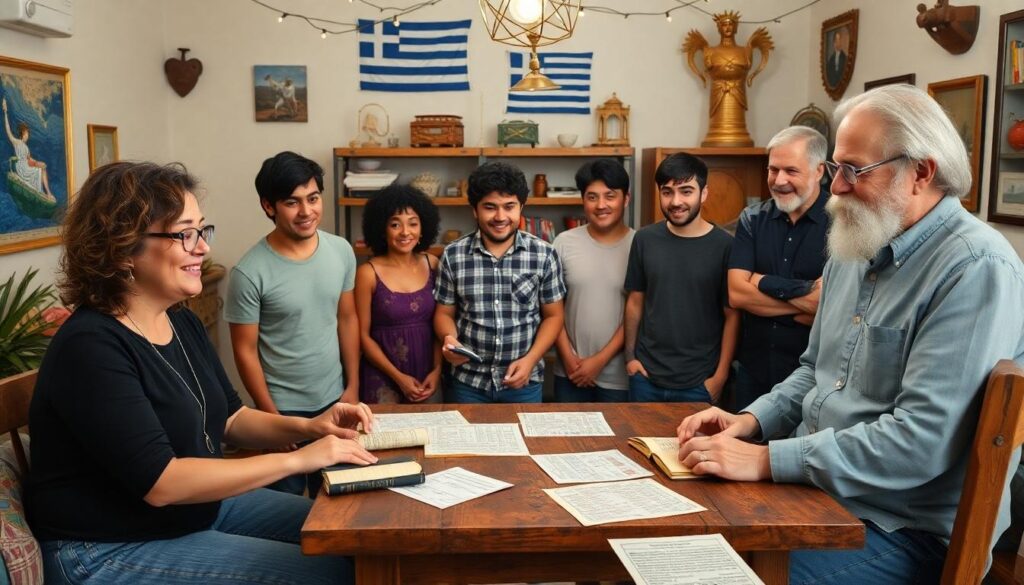Greek riddles have fascinated minds for centuries, challenging our intellect with their clever wordplay and profound philosophical undertones. These ancient brain teasers weren’t just entertainment—they were powerful tools used by Greek philosophers and scholars to stimulate critical thinking and teach important life lessons.
We’ve explored the intriguing area of Greek riddles to bring you a collection that showcases the brilliance of ancient Greek wisdom. From the famous Riddle of the Sphinx to lesser-known puzzles that have survived through generations, these mind-benders offer a unique glimpse into the Greek approach to problem-solving and intellectual discovery. Join us as we unravel these timeless enigmas that continue to challenge and delight puzzle enthusiasts around the industry.
Mysterious Ancient Greek Riddles That Challenged Philosophers
Ancient Greece wasn’t just the birthplace of democracy and philosophy—it was also home to some of the most challenging riddles ever conceived. These intellectual puzzles frequently stumped even the greatest thinkers of the era and continue to fascinate scholars today. Let’s explore seven profound Greek riddles that pushed philosophical boundaries and tested human wisdom.
The Paradox of Theseus’s Ship
The riddle of Theseus’s Ship asks a deceptively simple question: if you replace every plank of a ship one by one until none of the original materials remain, is it still the same ship? Philosophers like Plutarch and later Thomas Hobbes wrestled with this puzzle that challenges our understanding of identity and permanence. Many modern philosophers still debate this concept in discussions about personal identity and consciousness.
Zeno’s Dichotomy Paradox
Zeno of Elea crafted this mind-bending riddle: before you can travel a certain distance, you must first travel half that distance, and before that, half of that half, and so on infinitely—so how can anyone ever begin to move? This paradox challenged Greek thinkers to reconsider their understanding of infinity, space, and motion. Aristotle himself attempted to resolve this puzzle by introducing concepts that would later influence calculus.
The Liar Paradox of Epimenides
“All Cretans are liars,” declared Epimenides, who was himself a Cretan. This self-referential statement creates a logical trap—if true, it must be false, and if false, it must be true. Philosophers including Aristotle and later logicians spent centuries attempting to unravel this contradiction. The paradox eventually contributed to fundamental developments in mathematical logic and set theory.
The Sorites Paradox (The Heap)
How many grains of sand make a heap? If one grain isn’t a heap, and adding one grain to something that isn’t a heap doesn’t make it a heap, then how can any number of grains form a heap? This ancient Greek puzzle challenged philosophers to define boundaries and classifications. The Stoics and Megarians particularly struggled with this vexing problem of vague predicates and fuzzy boundaries.
The Crocodile Dilemma
A crocodile captures a child and tells the father: “I’ll return your child if you correctly guess whether I’ll return your child or not.” This paradoxical trap demonstrates the problem of self-reference in propositions. If the father guesses the crocodile will return the child, but the crocodile doesn’t, was the guess incorrect? Greek sophists used this riddle to demonstrate logical inconsistencies and the limitations of language.
The Achilles and the Tortoise Paradox
Another of Zeno’s paradoxes posits that swift Achilles can never overtake a tortoise given a head start, as Achilles must always reach the tortoise’s previous position first. This seemingly absurd conclusion challenged Greek mathematicians and philosophers to reconsider their understanding of motion and infinity. Modern calculus eventually provided mathematical answers to this ancient conundrum.
The Horn Dilemma
“What you have not lost, you have. You have not lost horns. Hence, you have horns.” This deceptive syllogism exemplifies faulty logic that nonetheless appears valid on its surface. Stoic philosophers used this riddle to demonstrate how language can create false impressions of reality. Their analysis of such riddles contributed significantly to the development of formal logic and argumentation techniques.
The Riddle of the Sphinx: Greece’s Most Famous Brain Teaser
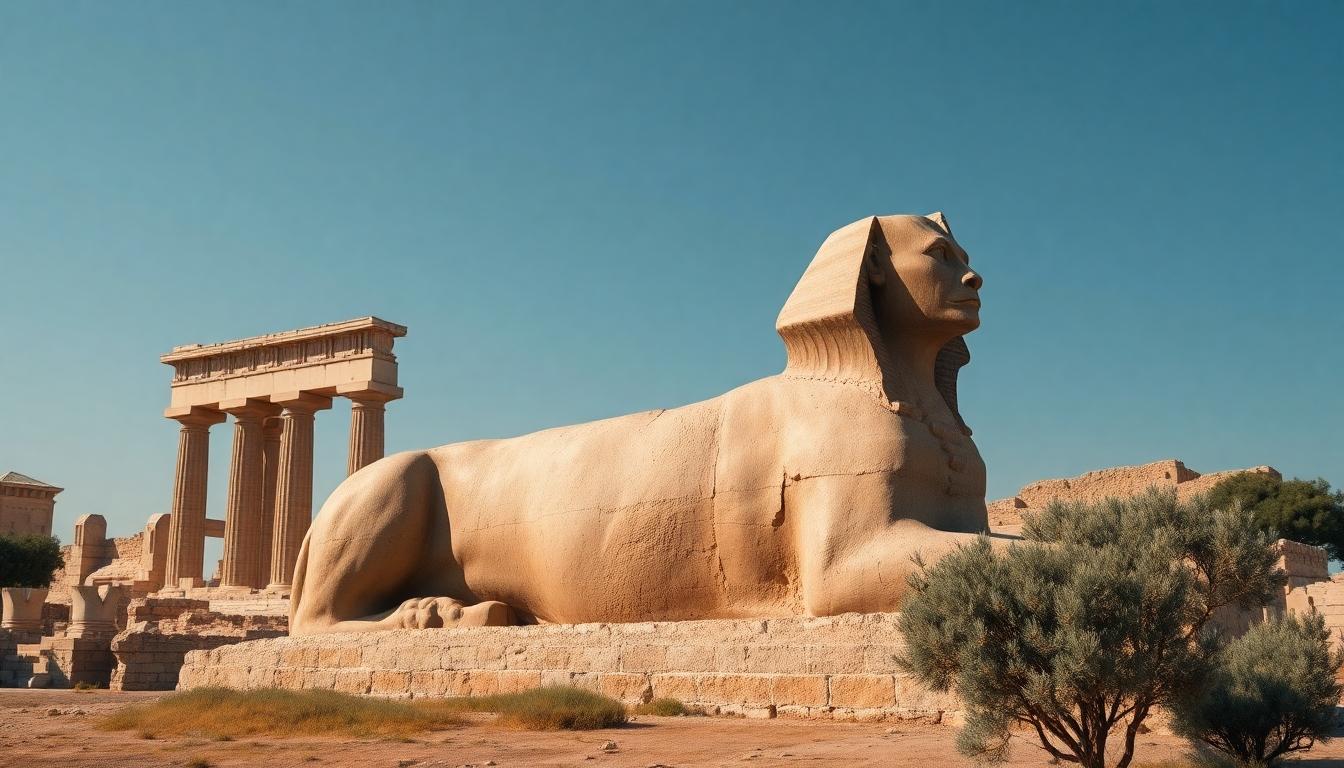
Among all Greek riddles, none has captured the imagination quite like the enigmatic question posed by the Sphinx. This legendary brain teaser stands as the cornerstone of Greek mythological tradition and continues to fascinate minds across generations.
Origins of the Sphinx’s Riddle
The famous riddle originates from the Theban Sphinx, a fearsome hybrid creature with a lion’s body and human head. Ancient sources tell us this mythological beast was sent by either Hera or Dionysus to plague the city of Thebes as punishment. First appearing in Sophocles’ renowned tragedy “Oedipus Rex,” the riddle also existed in earlier oral traditions that shaped Greek mythology. Some accounts mention a second, lesser-known riddle involving two sisters who continually birth each other—possibly representing night and day or the moon and sun. Scholars continue to debate these additional details, though the primary riddle remains firmly established in classical literature.
How Oedipus Solved the Impossible Question
The Sphinx’s notorious riddle asked: “What walks on four legs in the morning, two legs at noon, and three legs in the evening?” Oedipus brilliantly solved this seemingly impossible question with the answer “man”—representing the stages of human life. Infants crawl on all fours, adults walk upright on two legs, and the elderly often rely on a cane as a third support. This triumph of human logic over the monstrous Sphinx led directly to Oedipus becoming king of Thebes, though it eventually set him on the path to his tragic downfall. Solving the riddle required metaphorical thinking, combining everyday observation with symbolic interpretation—a perfect example of the intellectual prowess valued in Greek culture. The episode powerfully illustrates a recurring theme in Greek mythology: wisdom can be both humanity’s greatest achievement and a potential source of hubris.
Pythagoras and His Mathematical Riddles for Disciples
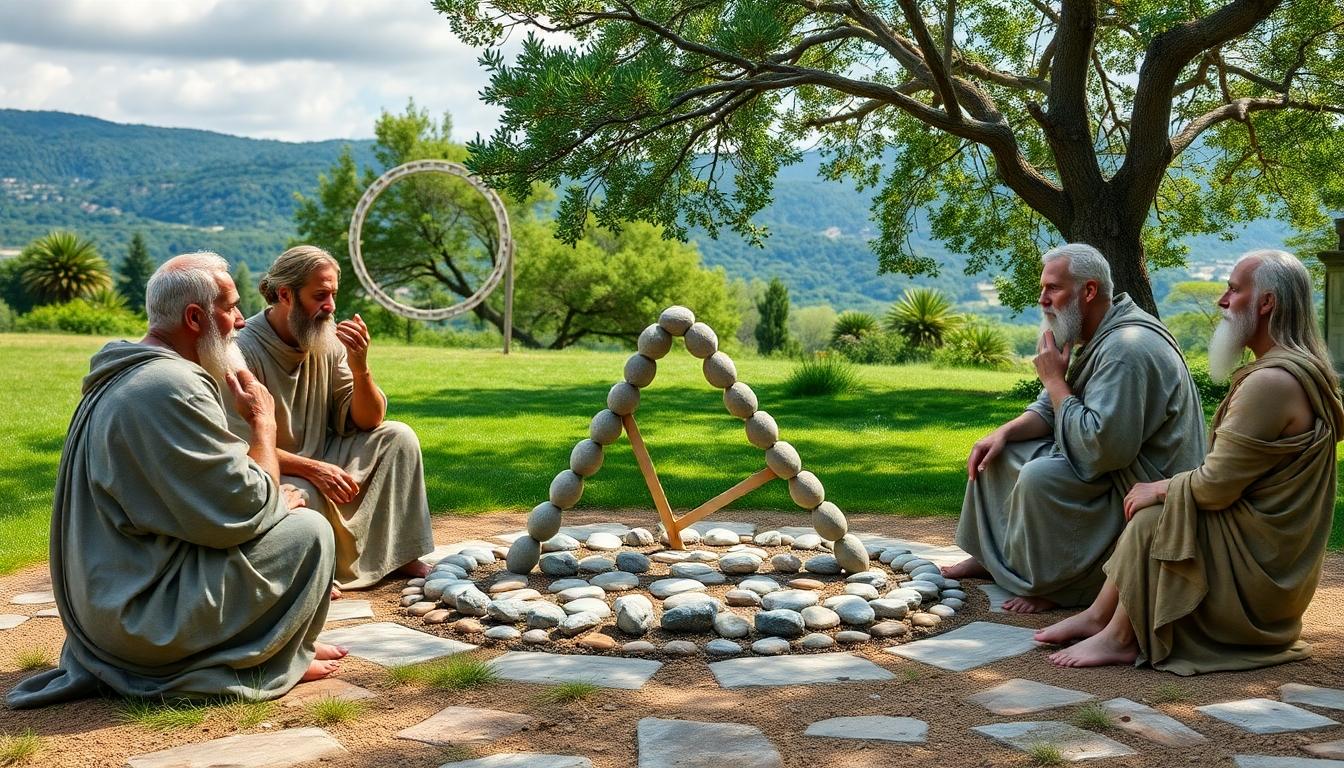
The Pythagorean cult of the 6th-5th century BCE wasn’t just a philosophical school—it was a community where mathematical riddles served as sacred tools for teaching deeper truths about the universe. Members pledged allegiance to Pythagoras and his mathematical principles, believing numbers were the fundamental building blocks of reality.
The Tetractys Puzzle
The tetractys represented one of the most sacred symbols in Pythagorean teaching, consisting of a triangular figure with 10 points arranged in four rows (1, 2, 3, and 4). Disciples revered this arrangement as the “root of ever-flowing nature” because it created the perfect sum of 10 when added together. Pythagoras and his followers interpreted this mathematical formation as the key to understanding cosmic harmony, governing everything from musical scales to planetary orbits. Students faced challenges that required recognizing how the tetractys encoded numerical patterns present throughout natural phenomena. This symbol transcended simple mathematics, embodying ethical principles and metaphysical truths that formed the core of Pythagorean doctrine.
Numerical Challenges That Tested Greek Minds
Pythagorean teachers devised complex problems that required applying the famous Pythagorean theorem to real-industry scenarios. Students tackled riddles involving hypotenuse calculations, distance determinations, and geometric proofs as practical applications of their theoretical knowledge. These exercises blended empirical observation with mystical numerology, reinforcing the Pythagorean belief that numbers underpin all reality. Disciples encountered tests like explaining why only exact integer ratios produced harmonious musical sounds or demonstrating how geometric demonstrations revealed universal truths. The mathematical challenges weren’t merely academic exercises—they functioned as spiritual tests designed to cultivate understanding of numbers as divine entities. This numerical tradition has influenced educational practices throughout history, with many modern mathematical resources still employing theorem-based problem-solving approaches that emphasize pattern recognition and deductive reasoning.
Zeno’s Paradoxes: Philosophical Riddles That Still Perplex Today
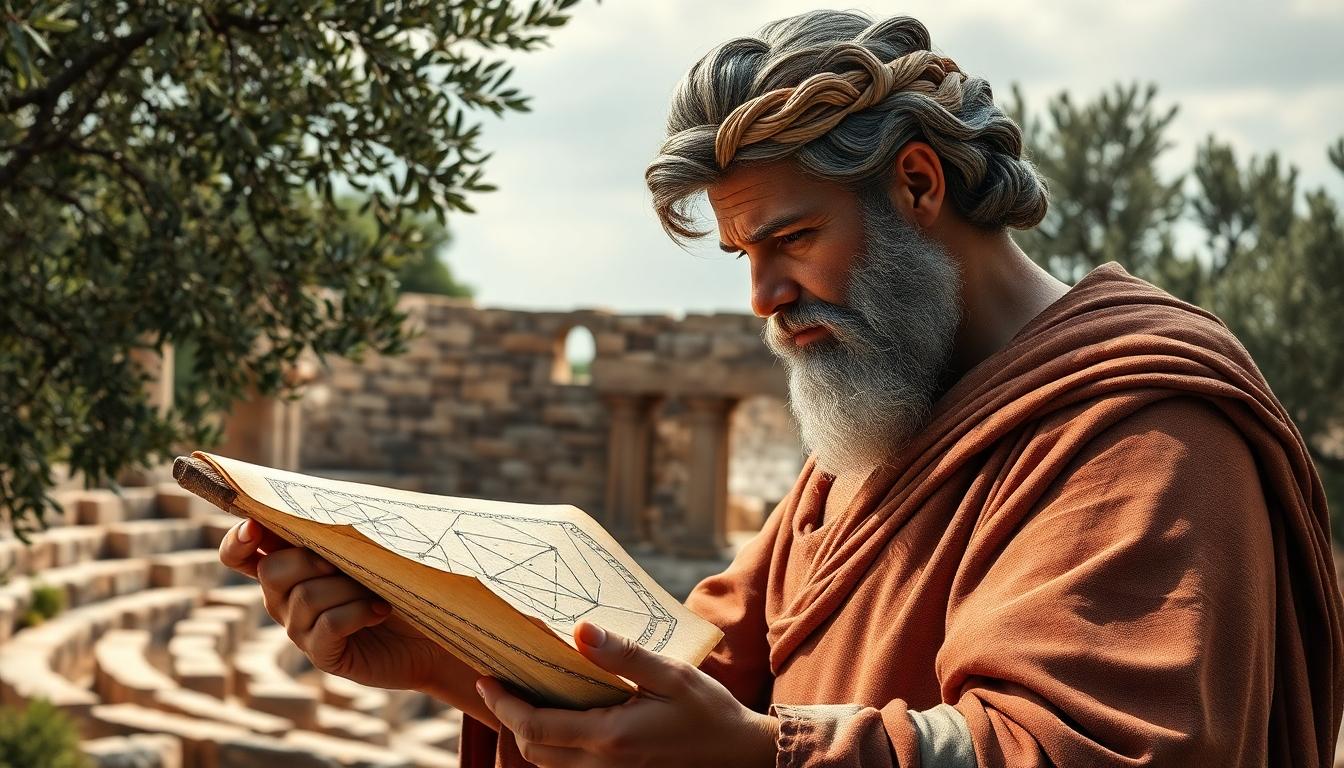
While not traditionally classified as riddles in ancient anthologies, Zeno’s Paradoxes function as philosophical puzzles that have challenged thinkers for centuries. These ingenious thought experiments from the 5th century BCE continue to provoke critical thinking about fundamental concepts of infinity, space, and motion.
The Dichotomy Paradox
The Dichotomy Paradox presents a deceptively simple yet profound challenge to our understanding of movement. According to this paradox, motion itself is impossible because reaching any destination requires first traversing an infinite number of halfway points. Before you can complete a journey, you must first travel half the distance, then half of the remaining distance, then half again—creating an endless series of steps that seemingly cannot be completed in finite time. This ancient thought experiment continues to intrigue mathematicians and philosophers today as it forces us to confront our intuitive understanding of infinity and continuity. The paradox serves as a perfect example of how Greek philosophical thinking used apparent contradictions to reveal deeper truths about reality.
Achilles and the Tortoise
Zeno’s paradox of Achilles and the Tortoise presents another perplexing scenario that challenges our understanding of motion and infinity. In this famous thought experiment, Achilles (a swift runner) races against a tortoise that has been given a head start. The paradox suggests that Achilles can never overtake the tortoise because he must first reach the point where the tortoise began. During this time, the tortoise advances further, creating a new point Achilles must reach, and this pattern continues infinitely. Even though our everyday experience confirming that faster objects do overtake slower ones, the paradox creates a logical trap that has fascinated mathematicians for millennia. Modern calculus offers answers through convergent series, but the philosophical implications about the nature of space and time remain thought-provoking. This paradox demonstrates how ancient Greek thinkers used logical puzzles to explore the fundamental nature of reality.
Greek Mythology Riddles That Determined Fate

In ancient Greek mythology, riddles weren’t merely clever wordplay but powerful tools that shaped destinies and determined the fate of mortals and kingdoms alike. These enigmatic challenges tested not just intelligence, but revealed the complex relationship between human agency and divine predestination.
Riddles of the Oracle at Delphi
The Oracle of Delphi delivered some of mythology’s most consequential riddles through cryptic prophecies that guided—or misguided—those who sought divine insight. Consulting the Oracle often resulted in ambiguous predictions that functioned as elaborate riddles, challenging seekers to interpret their meaning correctly. Oedipus received the devastating prophecy that he would “kill his father and marry his mother,” setting in motion a tragic chain of events even though his desperate attempts to avoid this fate. Though he fled his home to prevent the prophecy’s fulfillment, his actions ironically led him directly to his destiny, demonstrating how inescapable fate remained even though human cleverness. Perseus faced a similar situation when a prophecy foretold he would kill his grandfather—a fate that manifested through an accidental act, reinforcing the Greek belief that predetermined outcomes couldn’t be circumvented through rational planning. These oracular riddles taught an essential lesson: even when mortals understood the literal meaning of the prophecy, they frequently misinterpreted its application to their lives, walking blindly into the very fate they sought to avoid.
How Heroes Used Wit to Overcome Godly Tests
Greek heroes frequently relied on intellect rather than brute strength to navigate divine challenges and tests of fate. Theseus demonstrated remarkable wit when confronting the Labyrinth, using Ariadne’s thread as a simple yet ingenious solution to navigate the complex maze that symbolized fate’s intricate web. This strategic thinking allowed him to defeat the Minotaur and escape a structure specifically designed to be inescapable. The Sphinx’s famous riddle—”What walks on four legs in the morning, two at noon, and three in the evening?”—presented Oedipus with a life-or-death puzzle that threatened the entire city of Thebes. His correct answer of “Man” (representing the stages of human life from crawling infant to walking adult to elderly person with a cane) saved the city but ironically contributed to his tragic destiny. Greek mythology consistently shows that while heroes could overcome exact challenges through cleverness, they remained subject to the Three Fates—Clotho who spun life’s thread, Lachesis who measured it, and Atropos who cut it. Even Achilles, nearly invulnerable except for his heel, eventually met his prophesied end, illustrating that while wit might delay fate temporarily, the predetermined course of destiny remained absolute in the Greek worldview.
Greek Word Puzzles That Improved Ancient Education
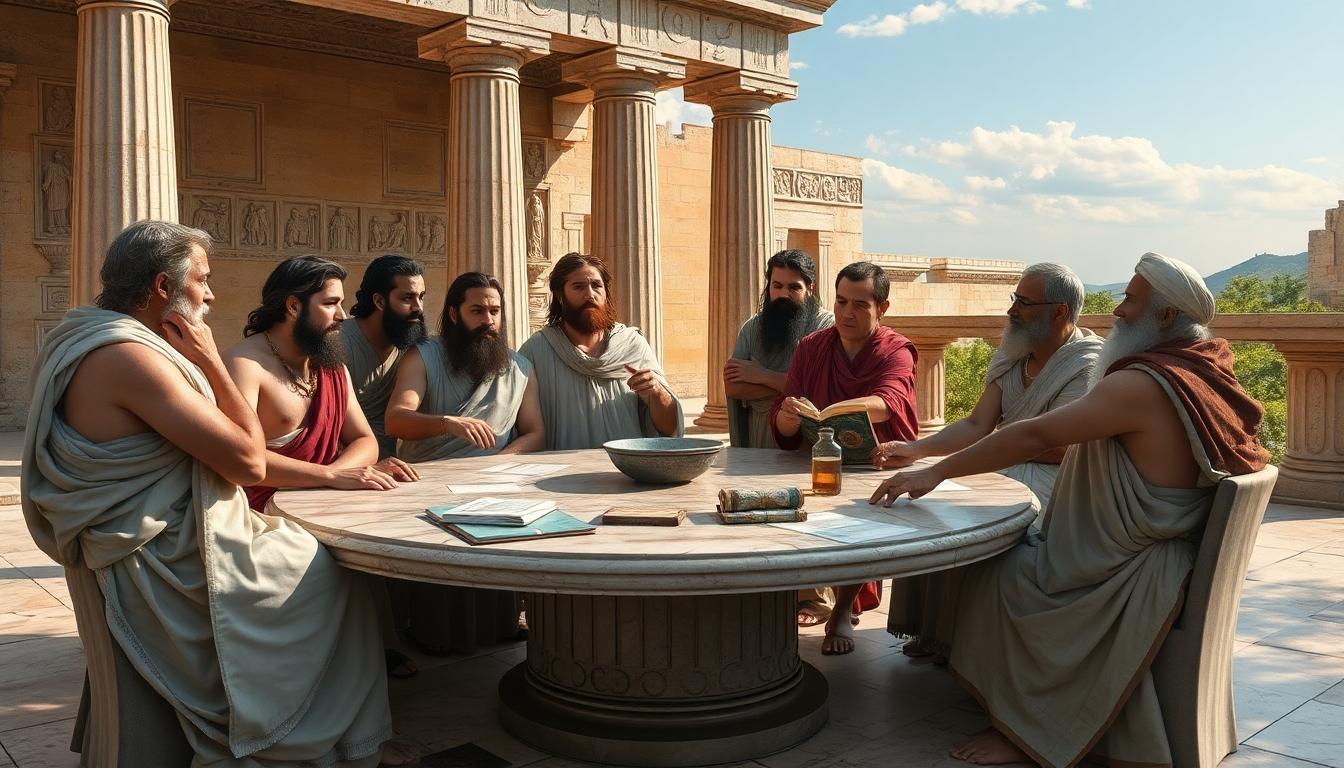
Ancient Greek civilization valued intellectual development, using various word puzzles as educational instruments that shaped young minds and fostered critical thinking abilities.
The Greek Acrostic Tradition
Greek acrostics represented an important yet less documented form of educational wordplay in ancient Greece. Though exact examples are scarcer than other word puzzles, we know they appeared in both poetic and instructional contexts throughout the Hellenic industry. Later Roman adaptations like the famous Sator Square suggest these acrostic patterns had cross-cultural influence and educational value. Hellenic teachers likely employed acrostics as effective literacy tools, helping students master the alphabet while captivating their minds in pattern recognition. Even though limited direct evidence compared to riddles, acrostics served as memory aids that reinforced linguistic skills through creative word arrangement.
Riddles as Teaching Tools in Hellenic Schools
Riddles formed a cornerstone of ancient Greek education, earning recognition from philosophical giants like Plato. In his Republic (479c), Plato observed children’s natural attraction to riddle play, recognizing this innate curiosity as educationally valuable. Greek educators deliberately incorporated riddles to develop lateral thinking and problem-solving capabilities in their students. These puzzles created competitive learning environments that motivated young scholars to think beyond conventional boundaries. Aristotle specifically connected riddles to metaphorical thinking in his Rhetoric, arguing they trained students to “see the similar in the dissimilar” – a fundamental skill for abstract reasoning. Riddles served multiple educational functions, including metaphorical training that bridged concrete and abstract thought, community bonding through collective problem-solving during symposia, and exploration of divine mysteries through oracle riddles. Famous examples like the Riddle of the Sphinx challenged individuals to decode layered meanings, preparing students for the complex thinking required in philosophy and public discourse. These intellectual puzzles blended entertainment with serious educational purposes, creating a multidisciplinary approach to learning that shaped some of history’s greatest thinkers.
Olympic Games and Their Connection to Greek Riddles

The relationship between Greek riddles and the Olympic Games is often misunderstood as being directly connected, when historical evidence suggests otherwise. Ancient Greek culture celebrated both intellectual challenges and athletic prowess, but these traditions developed along separate paths. While the Sphinx posed life-or-death riddles in mythology, the Olympic Games emerged from different origins entirely.
Mythological Origins of the Olympic Games
Olympic tradition attributes the founding of the games to Prince Pelops, who established them after winning a chariot race against King Oinamoas through deception. His victory celebration evolved into what we know as the Olympic Games, creating a lasting legacy that honors physical achievement rather than intellectual puzzles. The sacred grounds of Olympia became dedicated to Zeus, serving as the central location for these athletic competitions that united the Greek industry.
Distinct Cultural Elements
Greek riddles, exemplified by the famous Sphinx question about a creature walking on four, two, and three legs (answered as “human”), represented the intellectual tradition in ancient Greece. These brain teasers challenged mental acuity and philosophical thinking, operating in a completely different sphere from the physical contests at Olympia. Even though both being important elements of Hellenic culture, no historical documentation connects riddle-solving to Olympic events or ceremonies.
Shared Cultural Significance
Though not directly linked, both Greek riddles and the Olympic Games reflected core values of ancient Greek society. Athletic competitions demonstrated physical excellence and honored the gods, while riddles showcased the Greek appreciation for wisdom and mental agility. Together, these separate traditions paint a fuller picture of a civilization that valued both body and mind, creating cultural institutions that continue to influence us thousands of years later.
Ancient Greek Philosophers Who Used Riddles as Teaching Methods
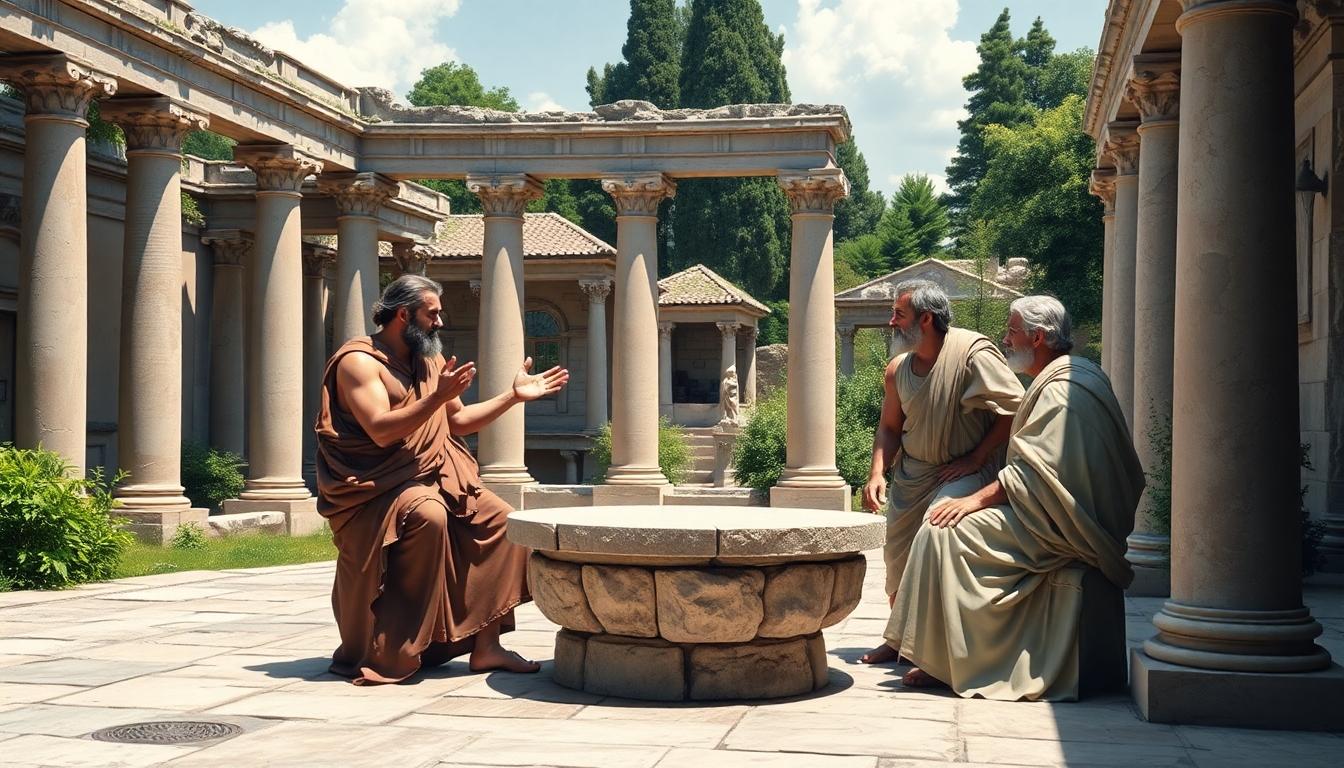
Ancient Greek philosophers frequently employed riddles, paradoxes, and thought experiments as powerful teaching tools to challenge their students’ minds and deepen their understanding of complex concepts. These intellectual puzzles served not as mere entertainment but as gateways to profound philosophical insights.
Aristotle’s Logic Puzzles
Aristotle’s approach to teaching involved sophisticated logical frameworks that functioned similarly to riddles in their ability to challenge intellect. His “Square of Opposition” outlined relationships between affirmations and denials, creating a framework that students could use to solve complex logical problems. This conceptual structure provided a systematic way for learners to navigate through challenging reasoning exercises. Aristotle’s syllogisms further exemplified his puzzle-like teaching methodology, presenting students with categorical sentences that required careful analysis and inference. Though not traditional riddles in form, these logical constructs demanded the same level of critical thinking and problem-solving skills that riddles typically evoke.
Plato’s Cave and Other Thought Experiments
Plato mastered the art of using allegorical stories as philosophical riddles that continue to challenge thinkers even today. The “Allegory of the Cave” stands as his most famous thought experiment, inviting students to question their perception of reality through a compelling narrative about prisoners mistaking shadows for reality. This powerful teaching tool functions as an extended riddle that asks: what constitutes true knowledge? Plato employed many other paradoxical scenarios throughout his dialogues that worked like intellectual puzzles, requiring students to untangle complex moral and epistemological questions. These thought experiments created cognitive dissonance that forced learners to reconsider their fundamental assumptions about knowledge, justice, and the nature of reality itself.
Modern Adaptations of Classic Greek Riddles
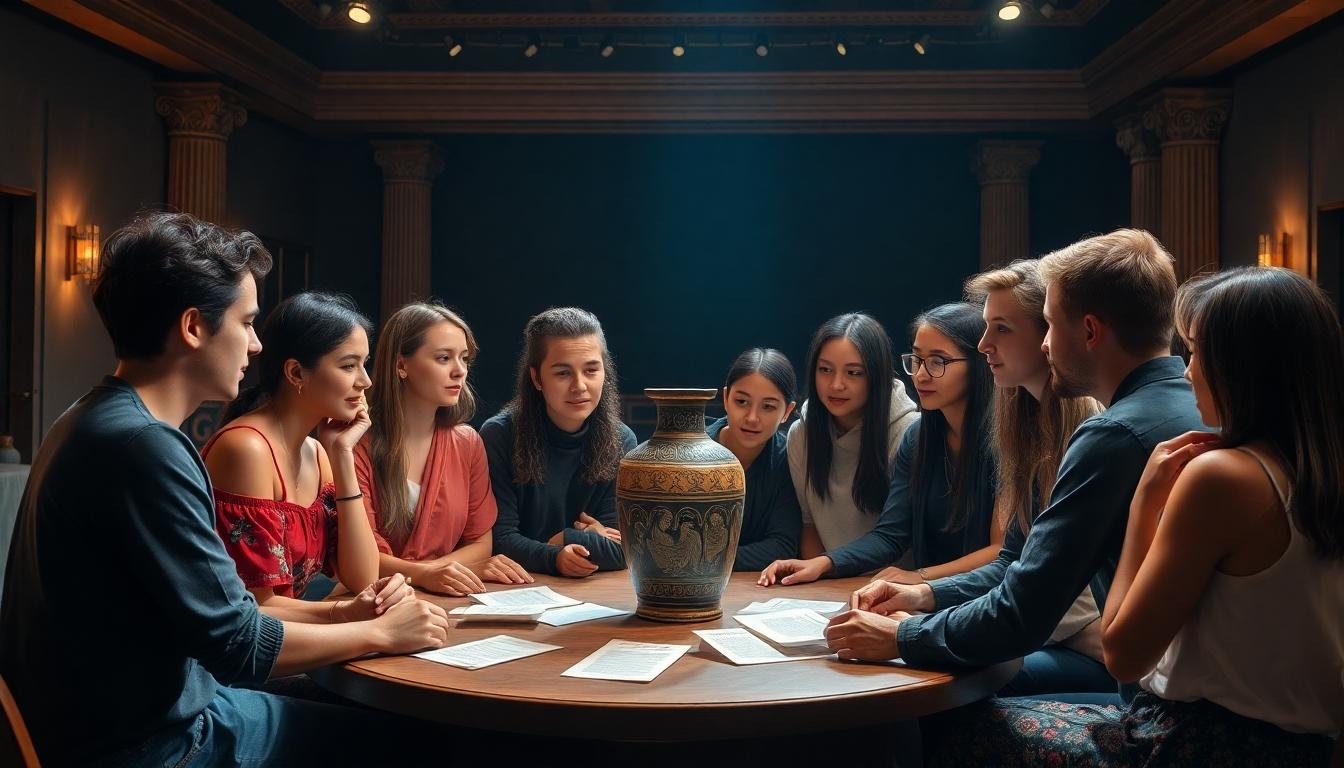
Influence on Modern Storytelling
Greek mythology and its intellectual challenges have found new life across various modern media formats. Literature, cinema, and games frequently incorporate elements reminiscent of ancient Greek riddles, adapting these intellectual puzzles for contemporary audiences. The puzzle-like scenarios featured in these adaptations celebrate mental acuity just as their ancient counterparts did thousands of years ago.
Theater productions and musicals draw important inspiration from Greek tragedies, often preserving the themes of intellectual challenge that were central to original Greek stories. Many productions maintain the tradition of presenting characters with puzzle-like scenarios that must be solved through wit and cleverness.
Riddles in Ancient Context
Ancient Greek riddles weren’t merely entertainment but served as intellectual games designed to celebrate mental sharpness. Unlike modern puzzles that might have practical applications, these classical riddles rarely provided useful information. Their primary purpose was testing intelligence and wit among participants, creating a culture that valued quick thinking and problem-solving abilities.
Current Interpretations
Modern retellings have breathed fresh life into ancient Greek mythological stories. Works like Stephen Fry’s Mythos present classical tales with contemporary perspectives, making them accessible to today’s audiences. While these modern adaptations might not always focus specifically on riddles, they often preserve the intellectual challenge aspects that made the original stories so compelling.
The influence of Greek intellectual games extends beyond direct adaptations into the strategic and creative elements of contemporary storytelling. Many modern narratives incorporate puzzle-solving and intellectual challenges reminiscent of Greek riddles, demonstrating how these ancient thought exercises continue to shape our approach to storytelling and entertainment today.
How to Solve Greek Riddles: Strategies From Ancient Wisdom
Greek riddles remain powerful tools for intellectual growth thousands of years after their creation. They challenge us to think beyond conventional logic and embrace paradox as a pathway to deeper understanding.
These ancient puzzles aren’t merely historical artifacts but living traditions that continue to shape our approach to problem-solving and critical thinking. The next time you encounter a modern puzzle or philosophical question remember you’re participating in a tradition that dates back to the dawn of Western civilization.
We hope these timeless enigmas inspire you to embrace the Greek philosophical tradition of questioning everything and finding wisdom in apparent contradictions. The journey through these riddles isn’t just about finding answers but about transforming how we think.
Frequently Asked Questions
What is the Riddle of the Sphinx and who solved it?
The Riddle of the Sphinx asked: “What walks on four feet in the morning, two in the afternoon, and three in the evening?” Oedipus solved it with the answer “man,” who crawls as a baby, walks upright as an adult, and uses a walking stick in old age. The riddle symbolizes the stages of human life and demonstrates the high value Greeks placed on intellectual ability.
How did ancient Greek philosophers use riddles in teaching?
Greek philosophers like Aristotle and Plato used riddles and paradoxes as pedagogical tools. Aristotle employed logical frameworks like syllogisms, while Plato created thought experiments such as the “Allegory of the Cave.” These methods created cognitive dissonance in students, challenging them to question assumptions and develop critical thinking skills essential to philosophical inquiry.
What is the Paradox of Theseus’s Ship?
The Paradox of Theseus’s Ship questions whether an object remains the same if all its components are gradually replaced. If Theseus’s ship has every plank replaced over time, is it still the same ship? This ancient Greek riddle explores fundamental concepts of identity, continuity, and what makes something essentially itself, issues still debated in modern philosophy.
What were Zeno’s Paradoxes about?
Zeno’s Paradoxes challenged conventional understanding of motion and infinity. The Dichotomy Paradox argues that to reach a destination, you must first reach halfway, then half of the remaining distance, creating infinite points to cross. The Achilles and Tortoise Paradox similarly demonstrates the problem of completing an infinite number of tasks in finite time. These paradoxes still influence mathematics and physics today.
How were riddles used in Greek mythology?
In Greek mythology, riddles often determined fate and tested heroes. The Oracle at Delphi delivered enigmatic prophecies that shaped destinies, while riddles presented by mythological creatures served as tests of wisdom. These challenges highlighted the Greek belief in the power of intellect and the complex relationship between human agency and divine predestination.
What was the Pythagorean approach to riddles?
The Pythagorean cult (6th-5th century BCE) used mathematical riddles as sacred educational tools. They believed numbers contained divine truths about the universe. The tetractys (a triangular figure of ten points) was particularly revered as it represented cosmic harmony. For Pythagoreans, solving mathematical riddles was not just intellectual exercise but spiritual practice revealing universal truths.
How have Greek riddles influenced modern culture?
Greek riddles have profoundly influenced modern storytelling, education, and entertainment. They appear in literature, films, and video games that celebrate mental acuity. Contemporary puzzle traditions, including logic puzzles and escape rooms, draw from this heritage. Educational approaches emphasizing pattern recognition and critical thinking also trace their lineage to ancient Greek intellectual traditions.
What is the Liar Paradox of Epimenides?
The Liar Paradox stems from Epimenides’ statement: “All Cretans are liars” (while being Cretan himself). This creates a logical trap: if true, it must be false; if false, it must be true. This self-referential paradox challenged ancient thinkers and continues to influence modern logic and mathematics, raising fundamental questions about truth, language, and the limitations of logical systems.
What distinguished Greek riddles from modern puzzles?
Greek riddles primarily functioned as intellectual games testing wisdom and wit, often with philosophical or moral dimensions. Modern puzzles, while intellectually challenging, frequently have practical applications or entertainment value. Greek riddles were embedded in cultural, religious, and philosophical contexts, whereas today’s puzzles are often distinct activities separated from broader cultural narratives.
How did the Greeks view the relationship between physical and intellectual prowess?
Greeks valued both physical and intellectual excellence as complementary virtues. While the Olympic Games celebrated physical prowess, riddles and philosophical contests honored mental acuity. This holistic appreciation reflects the Greek ideal of balanced development, where intellectual challenges were as important as athletic competitions in demonstrating human excellence and potential.

